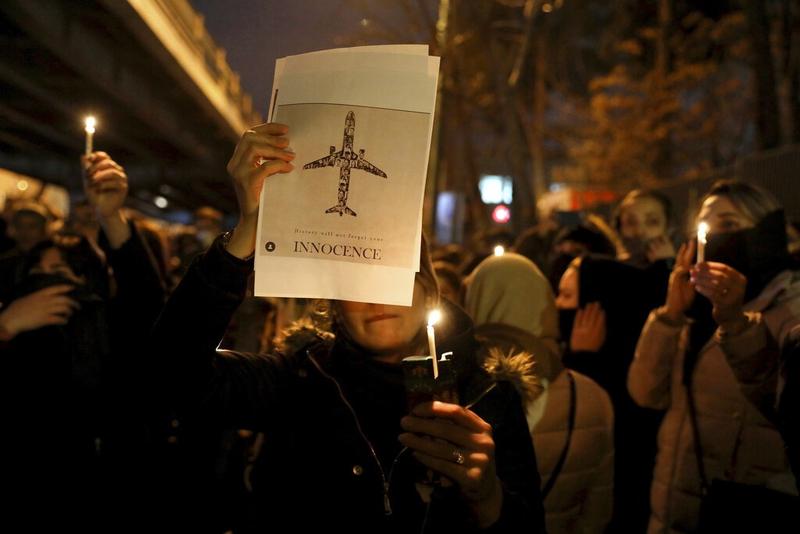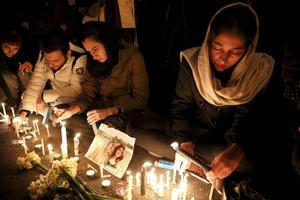 People gather for a candlelight vigil to remember the victims of the Ukraine plane crash, at the gate of Amri Kabir University that some of the victims of the crash were former students of, in Tehran, Iran, Jan 11, 2020. (EBRAHIM NOROOZI / AP)
People gather for a candlelight vigil to remember the victims of the Ukraine plane crash, at the gate of Amri Kabir University that some of the victims of the crash were former students of, in Tehran, Iran, Jan 11, 2020. (EBRAHIM NOROOZI / AP)
DUBAI – Protesters piled pressure on Iran's leadership on Sunday with demands for top authorities to quit after the Iranian military admitted it had mistakenly shot down a Ukrainian airliner at a time when it had feared US strikes.
"They are lying that our enemy is America, our enemy is right here," dozens of protesters outside a university in Tehran chanted, according to video clips posted on Twitter. Scores of demonstrators were also shown gathered in other cities.
The social media posts could not be verified by Reuters. But state-affiliated media had reported protests on Saturday shortly after the Iranian military apologized for mistakenly bringing down the Ukrainian plane on Wednesday, killing all 176 aboard.
The latest upsurge in anger adds to challenges facing the authorities, which launched a bloody crackdown in November to quell protests
Tehran residents told Reuters police were out in force in the capital on Sunday, as public anger boiled up following days of denials by the military that it was to blame, even as Canada and the United States said a missile had brought the plane down.
Riot police fired teargas at thousands of protesters in the capital on Saturday, where many had chanted "Death to the dictator", directing their anger at the Islamic Republic's Supreme Leader Ayatollah Ali Khamenei.
"Apologize and resign," Iran's moderate Etemad daily wrote in a banner headline on Sunday, saying the "people's demand" was for those responsible for mishandling the plane crisis to quit.
READ MORE: Iran says its military shot down Ukrainian plane by mistake
The latest upsurge in anger adds to challenges facing the authorities, which launched a bloody crackdown in November to quell protests. The leadership is also struggling to keep the crippled economy afloat under rigorous US sanctions.
The Ukraine International Airlines plane was shot down minutes after taking off from Tehran on Wednesday, when Iranian forces were on alert for US reprisals following tit-for-tat strikes. Many of those on board were Iranians with dual citizenship, while 57 were holders of Canadian passports.
Iran's president said it was a "disastrous mistake" and apologized. But a top Revolutionary Guards commander added to public fury when he said he had told the authorities on the same day as the crash that an Iranian missile had struck the plane.
The Guards' top commander, Hossein Salami, said "we are more upset than anyone over the incident", state media reported.
 People gather for a candlelight vigil to remember the victims of the Ukraine plane crash at the gate of Amri Kabir University that some of the victims of the crash were former students of, in Tehran, Iran, Jan 11, 2020. (EBRAHIM NOROOZI / AP)
People gather for a candlelight vigil to remember the victims of the Ukraine plane crash at the gate of Amri Kabir University that some of the victims of the crash were former students of, in Tehran, Iran, Jan 11, 2020. (EBRAHIM NOROOZI / AP)
REVENGE
But others said Iran's enemies, a term usually used to refer to Washington and its allies, were exploiting the incident.
"Iran's enemies want to take revenge on the Guards for a military mistake," said Ali Shirazi, Khamenei's representative to the Quds Force, an elite Guards unit, state media reported.
After Saturday's protests, US President Donald Trump said on Twitter: "There cannot be another massacre of peaceful protesters, nor an internet shutdown. The world is watching."
ALSO READ: US-Iran distrust looms over Tehran air crash investigation
Britain said its ambassador in Iran had been briefly detained on Saturday, which Iranian media said was because he was inciting protests. Some lawmakers said the envoy should leave Iran before being ejected, media reported.
Condemning the arrest, British Foreign Secretary Dominic Raab said Iran "can continue its march towards pariah status ...or take steps to de-escalate tensions and engage in a diplomatic path forwards."
Protests inside Iran followed a build-up of tension between Iran and the United States, which withdrew from Tehran's nuclear pact with world powers in 2018 and then toughened up sanctions.
On Jan 3, a US drone strike in Iraq killed prominent Iranian commander Qassem Soleimani, responsible for building up Iran's network of regional proxy armies in Iraq and beyond.
Tehran responded with missile strikes on US targets in Iraq.
No US soldiers were killed, but in the tense hours after that, the Ukrainian Boeing 737 was cleared to take off from Tehran airport and brought down by a missile fired in error.
Rallying to the establishment, Iranian lawmakers praised the elite force's commanders for courage in admitting the error, according to Fars, a news agency seen as close to the Guards, a parallel military set up to protect the theocratic system.
Iranian officials sought to portray the plane disaster as a second blow to a mourning nation after Soleimani's death in a US drone strike.
The commander's funeral had prompted huge public gatherings, which the authorities described as a show of national unity. But the displays of emotion have been swiftly overshadowed and protesters on Saturday tore up pictures of the slain general.
Public fury at Iran's authorities had grown as questions about the plane crash mounted. Iranians on social media asked why officials were busy fending off criticism from abroad rather than sympathizing with grieving families. Others asked why the plane was allowed to take off at a time of high tension.


